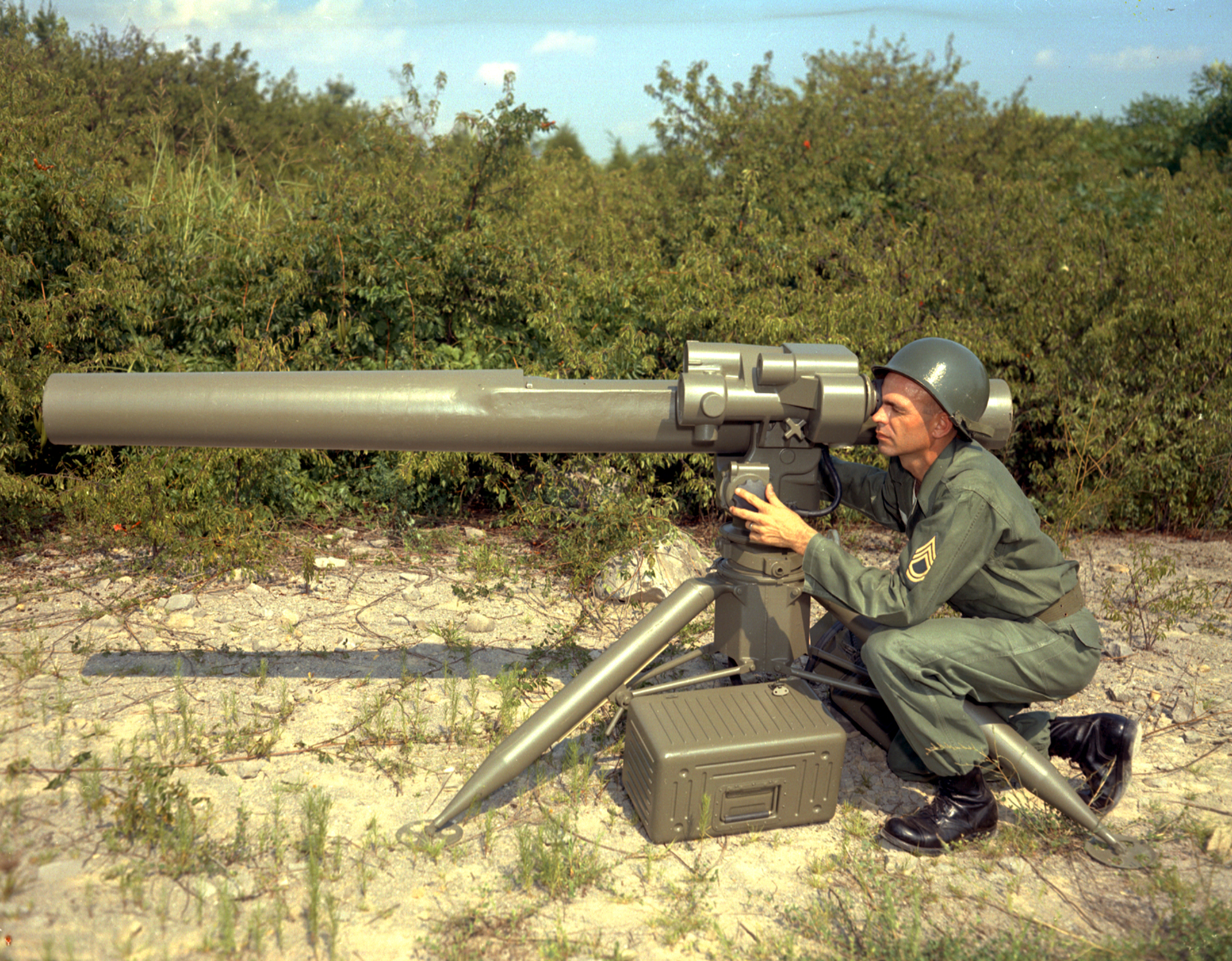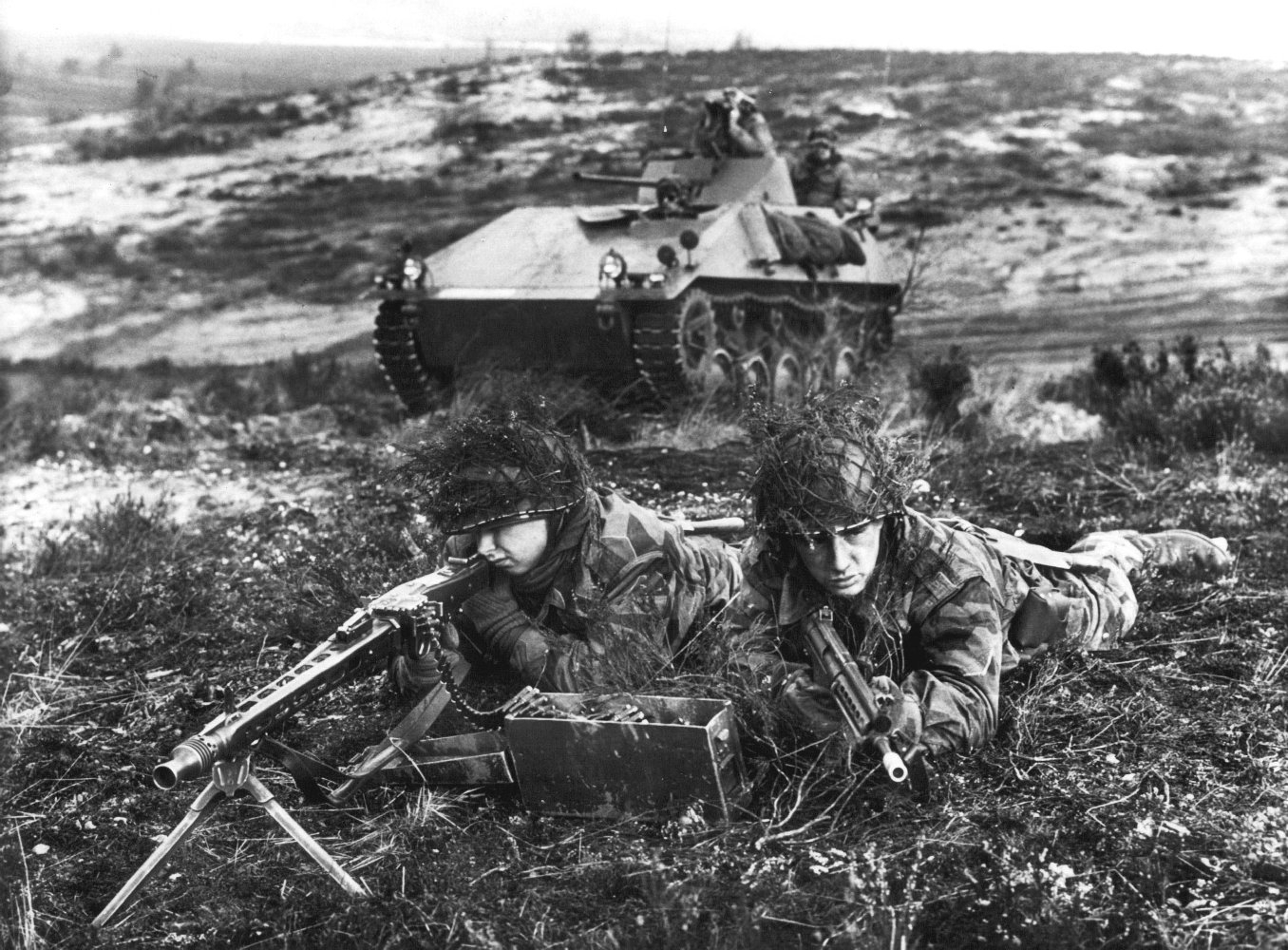|
NM142
The Norwegian Model-142 is an anti-tank variant of the American M113 armoured personnel carrier (APC), the difference being that it is equipped with a TOW2 turret developed in Norway by Kværner Eureka. Armament The NM-142 mounts a turret containing a TOW2 guided anti-tank missile system, with one launch tube on each side of the turret. Additionally, mounted on the commander's hatch, there is an MG3 machine gun for use as secondary armament and in situations where the TOW2-system is unsuitable. Organization The vehicle has a crew of four. The commander leads the crew, including designating targets, operating communication systems and navigating. The gunner is responsible for operating and maintaining the TOW2 weapon system. The loader assists the gunner, especially by reloading the launch tubes whenever necessary. Finally, the driver maneuvers the APC and is responsible for maintaining the engine, treads and other driving mechanisms. Usually, a platoon consists of four ... [...More Info...] [...Related Items...] OR: [Wikipedia] [Google] [Baidu] |
Tank Destroyers
A tank destroyer, tank hunter, tank killer, or self-propelled anti-tank gun is a type of armoured fighting vehicle, armed with a direct fire artillery gun or missile launcher, designed specifically to engage and destroy enemy tanks, often with limited operational capacities. While tanks are designed for front-line combat, combining operational mobility and tactical offensive and defensive capabilities and performing all primary tasks of the armoured troops, the tank destroyer is specifically designed to take on enemy tanks and other armoured fighting vehicles. Many are based on a tracked tank chassis, while others are wheeled. Since World War II, gun-armed powerful tank destroyers have fallen out of favor as armies have favored multirole main battle tanks. However, lightly armoured anti-tank guided missile (ATGM) carriers are commonly used for supplementary long-range anti-tank work. The resurgence of expeditionary warfare in the first two decades of the 21st century has s ... [...More Info...] [...Related Items...] OR: [Wikipedia] [Google] [Baidu] |
M901 ITV
The M901 ITV (Improved TOW Vehicle) is an American armored vehicle introduced into service in 1979, and designed to carry a dual M220 TOW launcher. It is based on the ubiquitous M113 Armored Personnel Carrier chassis. The M901 ITV is no longer in service with the United States Army, its primary user. Equipment The M901 ITV provides the crew and weapon system protection from small-arms fire and artillery fragments. The squad leader has a 270-degree range of view through the squad leader's periscope (SLP). The turret launcher has the capability for day and night acquisition and tracking of targets, and it provides firing coverages of 360 degrees in azimuth and +35 to −30 degrees in elevation. The ITV has stowage provisions for tripod-mounted TOW components configured so the ground system can be dismounted and set up in three to five minutes. In addition, the ITV is completely amphibious and is air transportable. It has the following characteristics: * A hydraulically and ... [...More Info...] [...Related Items...] OR: [Wikipedia] [Google] [Baidu] |
Anti-tank Warfare
Anti-tank warfare originated from the need to develop technology and tactics to destroy tanks during World War I. Since the Triple Entente deployed the first tanks in 1916, the German Empire developed the first anti-tank weapons. The first developed anti-tank weapon was a scaled-up bolt-action rifle, the Mauser 1918 T-Gewehr, that fired a 13mm cartridge with a solid bullet that could penetrate the thin armor of tanks of the time and destroy the engine or ricochet inside, killing occupants. Because tanks represent an enemy's strong force projection on land, military strategists have incorporated anti-tank warfare into the doctrine of nearly every combat service since. The most predominant anti-tank weapons at the start of World War II in 1939 included the tank-mounted gun, anti-tank guns and anti-tank grenades used by the infantry, and ground-attack aircraft. Anti-tank warfare evolved rapidly during World War II, leading to the inclusion of infantry-portable weapons such as ... [...More Info...] [...Related Items...] OR: [Wikipedia] [Google] [Baidu] |
Armoured Personnel Carrier
An armoured personnel carrier (APC) is a broad type of armoured military vehicle designed to transport personnel and equipment in combat zones. Since World War I, APCs have become a very common piece of military equipment around the world. According to the definition in the Treaty on Conventional Armed Forces in Europe, an APC is "an armoured combat vehicle which is designed and equipped to transport a combat infantry squad and which, as a rule, is armed with an integral or organic weapon of less than 20 millimetres calibre." Compared to infantry fighting vehicles (IFVs), which are also used to carry infantry into battle, APCs have less armament and are not designed to provide direct fire support in battle. Infantry units which travel in APCs are known as mechanized infantry. Some militaries also make a distinction between infantry units which use APCs and infantry units which use IFVs, with the latter being known as armoured infantry in such militaries. History The genesis o ... [...More Info...] [...Related Items...] OR: [Wikipedia] [Google] [Baidu] |
Kværner
Kværner was a Norwegian engineering and construction services company that existed between 1853 and 2005. In 2004, it was amalgamated to the newly formed subsidiary of Aker ASA - Aker Kværner, which was renamed Aker Solutions on 3 April 2008. Kværner re-emerged on 6 May 2011, when the EPC (engineering, procurement and construction) part of Aker Solutions took the Kværner name. The new Kværner company was listed on the Oslo Stock Exchange on 8 July 2011. History Kvaerner Brug was founded in Oslo in 1853 by industrialist Oluf A. Onsum (1820-1899). The company became principally involved in the production of cast iron stoves. In 1870, Kvaerner built its first hydroelectric turbine. During the early 1900s, Kvaerner power turbines remained the principal product line which also included bridges, cranes, and pumps. Kvaerner was listed on the Oslo Stock Exchange in 1967. By the 1990s, the company assembled a collection of engineering and industrial businesses, including shipbui ... [...More Info...] [...Related Items...] OR: [Wikipedia] [Google] [Baidu] |
BGM-71 TOW
The BGM-71 TOW ("Tube-launched, Optically tracked, Wire-guided") is an American anti-tank missile. TOW replaced much smaller missiles like the SS.10 and ENTAC, offering roughly twice the effective range, a more powerful warhead, and a greatly improved semi-automatic command to line of sight (SACLOS) that could also be equipped with infrared cameras for night time use. First produced in 1970, TOW is one of the most widely used anti-tank guided missiles. It can be found in a wide variety of manually carried and vehicle-mounted forms, as well as widespread use on helicopters. Originally designed by Hughes Aircraft in the 1960s, the weapon is currently produced by Raytheon. History Previous designs Late in World War II, the German Army began experimenting with modified versions of the Ruhrstahl X-4 wire-guided missile. Originally developed for the ''Luftwaffe'' as an anti-bomber weapon, by changing the warhead to one using a high-explosive anti-tank (HEAT) design, the new X-7 vers ... [...More Info...] [...Related Items...] OR: [Wikipedia] [Google] [Baidu] |
Rheinmetall MG3
The MG 3 is a German general-purpose machine gun chambered for the 7.62×51mm NATO cartridge. The weapon's design is derived from the World War II era MG 42 ''Einheitsmaschinengewehr'' (Universal machine gun) that fired the 7.92×57mm Mauser round.Woźniak, Ryszard: ''Encyklopedia najnowszej broni palnej—tom 3 M-P'', page 106. Bellona, 2001. The MG 3 was standardized in the late 1950s and adopted into service with the newly formed ''Bundeswehr'', where it continues to serve to this day as a squad support weapon and a vehicle-mounted machine gun. The weapon and its derivatives have also been acquired by the armed forces of over 40 countries. Production rights to the machine gun were purchased by Italy ( MG 42/59), Spain, Pakistan (MG 1A3), Greece, Iran, Sudan and Turkey. History At the end of World War II the original technical drawings and data for the 7.92×57mm Mauser chambered MG 42 were captured by the Soviets. These would eventually find their way to Czechoslovakia ... [...More Info...] [...Related Items...] OR: [Wikipedia] [Google] [Baidu] |
Lieutenant
A lieutenant ( , ; abbreviated Lt., Lt, LT, Lieut and similar) is a commissioned officer rank in the armed forces of many nations. The meaning of lieutenant differs in different militaries (see comparative military ranks), but it is often subdivided into senior (first lieutenant) and junior (second lieutenant and even third lieutenant) ranks. In navies, it is often equivalent to the army rank of captain; it may also indicate a particular post rather than a rank. The rank is also used in fire services, emergency medical services, security services and police forces. Lieutenant may also appear as part of a title used in various other organisations with a codified command structure. It often designates someone who is " second-in-command", and as such, may precede the name of the rank directly above it. For example, a "lieutenant master" is likely to be second-in-command to the "master" in an organisation using both ranks. Political uses include lieutenant governor in various g ... [...More Info...] [...Related Items...] OR: [Wikipedia] [Google] [Baidu] |
Squadron (army)
A squadron was historically a cavalry Subunit (military), subunit, a company or battalion-sized military formation. The term is still used to refer to modern cavalry Unit (military), units, and is also used by other arms and services (frequently Squadron (aviation), aviation, also Squadron (naval), naval). In some countries, including Italian Army, Italy, the name of the battalion-level cavalry unit translates as "''Squadron Group''". United States In the modern United States Army, a squadron is an armored cavalry, air cavalry, or other reconnaissance unit whose organizational role parallels that of a battalion and is commanded by a Lieutenant colonel (United States), lieutenant colonel. Prior to the revisions in the US Army structure in the 1880s, US Cavalry regiments were divided into Company (military unit), companies, and the battalion was an administrative designation used only in garrison. The reorganizations converted companies to troops and battalions to squadrons, a ... [...More Info...] [...Related Items...] OR: [Wikipedia] [Google] [Baidu] |
Armoured Warfare
Armoured warfare or armored warfare (mechanized forces, armoured forces or armored forces) (American English; American and British English spelling differences#-our, -or, see spelling differences), is the use of armoured fighting vehicle, armored fighting vehicles in modern warfare. It is a major component of modern Military science, methods of war. The premise of armoured warfare rests on the ability of troops to penetrate conventional Defense (military), defensive lines through use of Maneuver warfare, manoeuvre by armoured units. Much of the application of armoured warfare depends on the use of tanks and related vehicles used by other supporting arms such as infantry fighting vehicles, self-propelled artillery, and other combat vehicles, as well as mounted combat engineers and other support units. The doctrine of armoured warfare was developed to break the static nature of World War I trench warfare on the Western Front (World War I), Western Front, and return to the 19th ce ... [...More Info...] [...Related Items...] OR: [Wikipedia] [Google] [Baidu] |






.jpg)